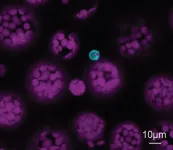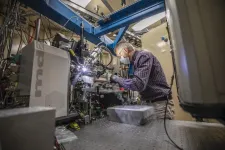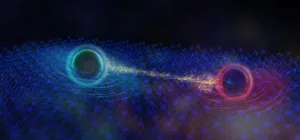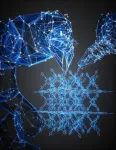Comprehensive characterization of vascular structure in plants
Biology: Key publication in The Plant Cell
2021-01-12
(Press-News.org) The leaf vasculature of plants plays a key role in transporting solutes from where they are made - for example from the plant cells driving photosynthesis - to where they are stored or used. Sugars and amino acids are transported from the leaves to the roots and the seeds via the conductive pathways of the phloem.
Phloem is the part of the tissue in vascular plants that comprises the sieve elements - where actual translocation takes place - and the companion cells as well as the phloem parenchyma cells. The leaf veins consist of at least seven distinct cell types, with specific roles in transport, metabolism and signalling.
Little is known about the vascular cells in leaves, in particular the phloem parenchyma. Two teams of Alexander von Humboldt professorship students from Düsseldorf and Tübingen, a colleague from Champaign Urbana in Illinois, USA, and a chair of bioinformatics from Düsseldorf have presented the first comprehensive analysis of the vascular cells in the leaves of thale cress (Arabidopsis thaliana) using single cell sequencing.
The team led up by Alexander von Humboldt Professor Dr. Marja Timmermans from Tübingen University was the first to use single cell sequencing in plants to characterise root cells. In collaboration with Prof. Timmermans' group, researchers from the Alexander von Humboldt Professor Dr. Wolf Frommer in Düsseldorf succeeded for the first time in isolating plant cells to create an atlas of all regulatory RNA molecules (the transcriptome) of the leaf vasculature. They were able to define the role of the different cells by analysing the metabolic pathways.
Among other things, the research team proved for the first time that the transcript of sugars (SWEET) and amino acids (UmamiT) transporters are found in the phloem parenchyma cells which transport these compounds from where they are produced to the vascular system. The compounds are subsequently actively imported into the sieve element companion cell complex via the second group of transporters (SUT or AAP) and then exported from the source leaf.
These extensive investigations involved close collaborations with HHU bioinformatics researchers in Prof. Dr. Martin Lercher's working group. Together they were able to determine that phloem parenchyma and companion cells have complementary metabolic pathways and are therefore in a position to control the composition of the phloem sap.
First author and leader of the work group Dr. Ji-Yun Kim from HHU explains: "Our analysis provides completely new insights into the leaf vasculature and the role and relationship of the individual leaf cell types." Institute Head Prof. Frommer adds: "The cooperation between the four working groups made it possible to use new methods to gain insights for the first time into the important cells in plant pathways and to therefore obtain a basis for a better understanding of plant metabolism."
INFORMATION:
Original publication
Ji-Yun Kim, Efthymia Symeonidi, Tin Yau Pang, Tom Denyer, Diana Weidauer, Margaret Bezrutczyk, Manuel Miras, Nora Zöllner, Thomas Hartwig, Michael M. Wudick, Martin Lercher, Li-Qing Chen, Marja C.P Timmermans & Wolf B. Frommer, Distinct identities of leaf phloem cells revealed by single cell transcriptomics, The Plant Cell, 2021
DOI: 10.1093/plcell/koaa060
[Attachments] See images for this press release:

ELSE PRESS RELEASES FROM THIS DATE:
2021-01-12
A team of HIV researchers, cellular biologists, and biophysicists who banded together to support COVID-19 science determined the atomic structure of a coronavirus protein thought to help the pathogen evade and dampen response from human immune cells. The structural map - which is now published in the journal PNAS, but has been open-access for the scientific community since August - has laid the groundwork for new antiviral treatments tailored specifically to SARS-CoV-2, and enabled further investigations into how the newly emerged virus ravages the human body.
"Using X-ray crystallography, we built an ...
2021-01-12
A new study published in the American Journal of Preventive Medicine found a 25% increase in food insufficiency during the COVID-19 pandemic. Food insufficiency, the most extreme form of food insecurity, occurs when families do not have enough food to eat. Among the nationally representative sample of 63,674 adults in the US, Black and Latino Americans had over twice the risk of food insufficiency compared to White Americans.
"People of color are disproportionately affected by both food insufficiency and COVID-19," said Jason Nagata, MD, MSc, assistant professor of pediatrics at the University of California, San Francisco and lead author on the study. "Many of these individuals have experienced job loss and higher rates of poverty during the ...
2021-01-12
During April 2020, while the UK was in full lockdown, there was a drop of more than a third in the number of people seeking help for mental illness or self-harm according to research involving 14 million people registered at general practices across the four nations of the UK which was published today in The Lancet Public Health*.
The research, 'Effects of the COVID-19 pandemic on primary care-recorded mental illness and self-harm episodes in the UK: a population-based cohort study', was conducted by the National Institute for Health Research Greater Manchester Patient Safety Translational Research Centre (NIHR GM PSTRC). The Centre is a partnership between The University of Manchester and Salford Royal NHS Foundation ...
2021-01-12
In a surprising discovery, Princeton physicists have observed an unexpected quantum behavior in an insulator made from a material called tungsten ditelluride. This phenomenon, known as quantum oscillation, is typically observed in metals rather than insulators, and its discovery offers new insights into our understanding of the quantum world. The findings also hint at the existence of an entirely new type of quantum particle.
The discovery challenges a long-held distinction between metals and insulators, because in the established quantum theory of materials, insulators were not thought to be able to ...
2021-01-11
Reston, Virginia--Physicians who follow artificial intelligence (AI) advice may be considered less liable for medical malpractice than is commonly thought, according to a new study of potential jury candidates in the U.S. Published in the January issue of The Journal of Nuclear Medicine (JNM). The study provides the first data related to physicians' potential liability for using AI in personalized medicine, which can often deviate from standard care.
"New AI tools can assist physicians in treatment recommendations and diagnostics, including the interpretation of medical images," remarked Kevin Tobia, JD, PhD, ...
2021-01-11
TORONTO, ON - New research led by researchers at the University of Toronto (U of T) and Northwestern University employs machine learning to craft the best building blocks in the assembly of framework materials for use in a targeted application.
The findings, published today in Nature Machine Intelligence, demonstrated that the use of artificial intelligence (AI) approaches can help in proposing novel materials for diverse applications. One example is the separation of carbon dioxide from industrial combustion processes. AI approaches promise the acceleration of the design cycle for materials.
With the objective of improving the separation of chemicals in industrial processes, the team of researchers - including collaborators from ...
2021-01-11
'This effort truly represents a "moonshot" in COVID-19 research'
Scientists identify target to treat COVID pneumonia and reduce severity
Clinical trials with new experimental drug to begin early in 2021
Goal is to develop treatments that make COVID-19 no worse than a common cold
First comparison between immune mechanisms driving COVID-19 pneumonia with other pneumonias
CHICAGO --- Bacteria or viruses like influenza that cause pneumonia can spread across large regions of the lung over the course of hours. In the modern intensive care unit, these bacteria or viruses are usually controlled either by antibiotics or by the body's immune system within ...
2021-01-11
How are networks of neurons connected to make functional circuits? This has been a long standing question in neuroscience. To answer this fundamental question, researchers from Boston Children's Hospital and Harvard Medical School developed a new way to study these circuits and in the process learn more about the connections between them.
"Neural networks are extensive, but the connections between them are really small," says Wei-Chung Allen Lee, PhD, of the F.M. Kirby Neurobiology Center at Boston Children's and Harvard Medical School. "So, we have had to develop techniques to see them in extremely high-resolution over really large areas and volumes." ...
2021-01-11
ORLANDO, Jan. 11, 2021 - Data from Arecibo Observatory in Puerto Rico has been used to help detect the first possible hints of low-frequency disturbances in the curvature of space-time.
The results were presented today at the 237th meeting of the American Astronomical Society, which was held virtually, and are published in The Astrophysical Journal Letters. Arecibo Observatory is managed by the University of Central Florida for the National Science Foundation under a cooperative agreement.
The disturbances are known as gravitational waves, which ripple through space as a result of the movement of incredibly massive objects, such as black holes orbiting one another or the collision of neutron stars.
It's important to understand these waves as they provide insight into the history ...
2021-01-11
CAMBRIDGE, MA -- When we experience a new event, our brain records a memory of not only what happened, but also the context, including the time and location of the event. A new study from MIT neuroscientists sheds light on how the timing of a memory is encoded in the hippocampus, and suggests that time and space are encoded separately.
In a study of mice, the researchers identified a hippocampal circuit that the animals used to store information about the timing of when they should turn left or right in a maze. When this circuit was blocked, the mice were unable to remember which way they were supposed to turn next. However, disrupting the circuit ...
LAST 30 PRESS RELEASES:
[Press-News.org] Comprehensive characterization of vascular structure in plants
Biology: Key publication in The Plant Cell



